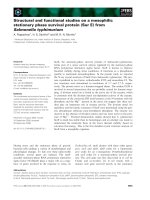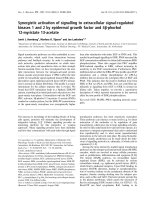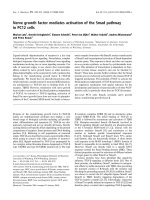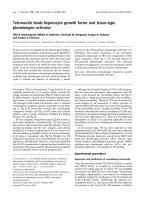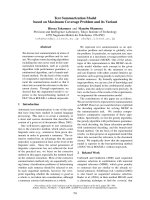Functional studies on nerve growth factor and its precursor from naja sputatrix
Bạn đang xem bản rút gọn của tài liệu. Xem và tải ngay bản đầy đủ của tài liệu tại đây (5.17 MB, 323 trang )
FUNCTIONAL STUDIES ON
NERVE GROWTH FACTOR AND ITS
PRECURSOR FROM NAJA SPUTATRIX
DAWN KOH CHIN ING
NATIONAL UNIVERSITY OF SINGAPORE
2007
FUNCTIONAL STUDIES ON
NERVE GROWTH FACTOR AND ITS
PRECURSOR FROM NAJA SPUTATRIX
DAWN KOH CHIN ING
B.Sc. (Hons)
A THESIS SUBMITTED FOR THE DEGREE OF
DOCTOR OF PHILOSOPHY
DEPARTMENT OF BIOCHEMISTRY
NATIONAL UNIVERSITY OF SINGAPORE
2007
Acknowledgements
I would like to extend my heart-felt appreciation to my supervisor and mentor,
Professor Kandiah Jeyaseelan. His mentorship, guidance, encouragement,
understanding and support not only enabled me to complete this project successfully
but also nurtured me to be a better researcher. My career as a researcher has just
begun, thanks Prof for giving me the necessary and essential skills to start off this
journey!
I am grateful to Dr. Arunmozhiarasi Armugam for training and guiding me. It is
great to have someone to share and exchange ideas with. I value her patience, ideas,
advice and motivation. In addition, I would like to thank her for showing me the joy,
hard work and frustration of research. Her passion and zeal for science is an
inspiration to me.
I would also like to thank the Head of Department of Biochemistry for giving me the
opportunity to pursue my studies in the department and the National University of
Singapore for providing a research scholarship throughout my course of study.
Special thanks to both past and present members of Prof Jay’s lab, especially
Charmain, Joyce and Siaw Ching for making this ‘marathon’ more enjoyable with
their friendship. Apart from them, I would like to thank all my friends in NUS for
their warmth, assistance, friendship and advice.
Most importantly, this thesis is dedicated to my family. They are my ardent
supporters, without them, I would not have made it this far. Their constant
encouragement and prayers have sustained me till this day. Thanks family for being
all that you are!
Finally, I would like to thank my personal Lord, Jesus Christ, for leading me to this
career as a researcher. In his heart a man plans his course, but the Lord determines
his steps (Proverbs 16: 9).
Table of Contents
Publications i
Summary ii
Abbreviations v
List of Tables ix
List of Figures x
Chapter 1: Introduction
1.1 Nerve Growth Factor (NGF) 2
1.1.1 Neurotrophin family 3
1.1.2 Structure of NGF 4
1.1.3 Biosynthesis of NGF 6
1.1.3.1 Debate on functionality of proNGF 7
1.2 NGF receptors 9
1.2.1 Trk receptors 9
1.2.1.1. Structure of TrkA and NGF 10
1.2.1.2 Trk receptor-mediated signaling
mechanisms
14
1.2.2 P75 neurotrophin receptors
(p75
NTR
)
19
1.2.2.1 Structure of p75
NTR
and NGF 20
1.2.2.2 Functional roles of p75
NTR
22
1.2.2.2.1. P75
NTR
receptor-mediated
apoptotic signal
22
1.2.2.2.2 P75
NTR
receptor-mediated pro-
survival signal
24
1.2.3 Cross-talk between TrkA and
p75
NTR
26
1.3 Therapeutic applications of NGF 29
1.3.1 Neuropathies of the peripheral
nervous system
29
1.3.1.1 Genetic neuropathy 30
1.3.1.2 Leprous neuropathy 30
1.3.1.3 Diabetic sensory polyneuropathy 31
1.3.1.4 Traumatic neuropathy and pain 32
1.3.2 Neuropathies of the central
nervous system
32
1.3.2.1 Alzheimer’s disease (AD) 33
1.3.3 Corneal and cutaneous ulcers 34
1.4 NGF from snakes 35
1.4.1 Venomous snakes 36
1.4.2 The Elapids 38
1.4.3 Naja Sputatrix and its venom 40
1.5 Aims of this project 41
Chapter 2: Materials and Methods
2.1 Materials 44
2.1.1 Bacteria and media 44
2.1.2 Plasmids 45
2.1.2.1 Reagents for plasmid isolation 46
2.1.3 Antibiotics 47
2.1.4 Cell lines and culture media 48
2.1.5 Organotypic hippocampal cultures 49
2.1.6 Naja sputatrix venom 51
2.1.7 Buffers and solutions 51
2.1.8 Reagents for DNA and RNA
isolation
52
2.1.8.1 Reagents for DNA gel
electrophoresis
52
2.1.8.2 Reagents for the RNA gel
electrophoresis
53
2.1.9 Reagents for real-time polymerase
chain reaction (Real-time PCR)
54
2.1.10 Reagents for oligonucleotide
microarray
55
2.1.11 Reagents for the isolation of
proteins
57
2.1.12 Reagents for purification of
histidine-tagged fusion proteins by
denaturing conditions
58
2.1.13 Reagents for Tris-tricine SDS-
PAGE (Protein gel)
60
2.1.14 Reagents for Western blotting 61
2.1.15 Reagents for MTT cell viability
assay
62
2.1.16 Kit for apoptotic, necrotic and
healthy cells assay
62
2.1.17 Cytotoxicity assay (LDH) 62
2.1.18 Reagents for caspase-3 activity
assay
62
2.2 Methods
64
2.2.1 Electrophoresis 64
2.2.1.1 DNA gel electrophoresis 64
2.2.1.1.1 DNA extraction from agarose gels 64
2.2.1.2 RNA gel electrophoresis 65
2.2.2 Enzymatic reactions 66
2.2.2.1 Restriction endonuclease digestion
of DNA
66
2.2.2.2 Ligation 66
2.2.3 Purification of nerve growth factor
and phospholipase A
2
from
crude venom
67
2.2.4 Methods for DNA cloning 67
2.2.4.1 Isolation of total cellular RNA
from snake
67
2.2.4.2. Reverse Transcription Polymerase
Chain Reaction (RT-PCR)
68
2.2.4.3 Cloning 69
2.2.4.4 Transformation 69
2.2.4.5 Plasmid DNA isolation 70
2.2.4.6 Sanger Dideoxy DNA sequencing 70
2.2.4.6.1 Sequencing reaction 71
2.2.4.6.2 Purification of sequencing
products
71
2.2.5 Expression and purification of
recombinant sputa NGF protein
from E.coli
72
2.2.5.1 Refolding of recombinant sputa
NGF
73
2.2.5.2 Circular dichroism (CD) 73
2.2.6 Expression of recombinant sputa
NGF protein from mammalian
CHO cells
74
2.2.6.1 DNA transfection 74
2.2.6.2 Generation of stable NGF clones 76
2.2.6.3 Quantitation of plasmid copy
number in stable CHO
transfectants
76
2.2.6.4 Induction of expressed proteins in
cell culture media
78
2.2.7 Gene expression studies 78
2.2.7.1 Isolation of total cellular RNA
from PC12 cells and hippocampal
tissue slices
78
2.2.7.2 Quantitative real-time polymerase
chain reaction (real-time PCR)
79
2.2.7.2.1 Principles of real-time PCR 79
2.2.7.3 Oligonucleotide microarray 81
2.2.7.3.1 Principles of microarray 81
2.2.7.3.2 cDNA probe preparation 83
2.2.7.3.3 Clean-up of double stranded
cDNA
85
2.2.7.3.4 Synthesis of biotin-labeled cRNA 85
2.2.7.3.5 Clean-up and quantification of in
vitro transcription (IVT) products
86
2.2.7.3.6 Fragmentation of cRNA for target
preparation
87
2.2.7.3.7 Eukaryotic target hybridization 88
2.2.7.3.8 Washing, staining and scanning 89
2.2.7.3.9 Microarray data analysis 90
2.2.7.4 Applications of gene expression
studies
91
2.2.8 Protein analysis 92
2.2.8.1 Protein Isolation from cells 92
2.2.8.2 Protein determination using the
Bradford method
93
2.2.8.3 Tris-tricine SDS-PAGE 93
2.2.8.4 Western blotting 94
2.2.8.5 Principles of protein profiling by
surface-enhanced laser-desorption-
ionization time- of-flight (SELDI-
TOF)
95
2.2.8.5.1 Sample preparation for SELDI-
TOF
97
2.2.8.5.2 SELDI-TOF 97
2.2.8.5.3 SELDI-TOF analysis 97
2.2.8.5.4 Applications for SELDI-TOF 98
2.2.9 Biochemical assays 98
2.2.9.1 Detection of DNA fragmentation 98
2.2.9.2 MTT cell viability test 99
2.2.9.3 LDH (lactate dehydrogenase)
cytotoxicity test
100
2.2.9.4 Assay for the determination of
caspase-3 activity
101
2.2.9.5 Annexin V / Ethidium homodimer
III / Hoechst nuclear staining
101
2.2.10 Organotypic hippocampal culture 102
2.2.10.1 Obtaining hippocampal slices from
rats
102
2.2.10.2 Maintenance of hippocampal
slices
105
2.2.10.3 Procedure for analysing cell
damage
105
2.3 Chemicals and reagents 107
Chapter 3: Sputa Nerve Growth Factor (Sputa NGF)
3.1 Introduction 110
3.2 Methods of NGF purification from
snake venoms
111
3.2.1 Gel filtration 112
3.2.2 RP-HPLC 112
3.3 Screening of NGF activity from
venom fractions using PC12 cells
114
3.4 cDNA cloning of the nerve growth
factor from N. sputatrix
116
3.5 Expression of NGF in E. coli 116
3.6 Production of recombinant sputa
NGF
118
3.7 Biological activity of recombinant
sputa NGF
118
3.8 Activation of TrkA receptors 123
3.9 Real-time PCR analysis after NGF
treatment
123
3.10 Protein profiling (SELDI-TOF)
analysis
127
3.11 Microarray analysis of NGF
treated PC12 cells
129
Chapter 4: The pro-domain of sputa NGF
4.1 Introduction 134
4.2 Analysis of sequence by
bioinformatics tools
134
4.3 Plasmid construction 137
4.3.1 Tet on/off system in CHO cells 144
4.3.2 Generation of stable cell line that
is tetracycline-regulated
144
4.3.3 Selection of clones with equal
copy number
146
4.3.4 Expression of recombinant
proteins from stable transfectants
150
4.4 Neurite outgrowth activity of sputa
NGF proteins on PC12 cells
150
4.4.1 Competitive antibody inhibition 151
4.4.2 Analysis of cell death by
fluorescence microscopy
154
4.4.3 Assessment of cell death by lactate
dehydrogenase (LDH) and
caspase assay
156
4.4.4 Detection of oligonucleosomal
DNA fragmentation
160
4.4.5 Inhibition by caspase-3-specific
inhibitor
160
4.4.6 Real-time PCR analysis 162
4.4.7 Western blot analysis of NGF
receptor proteins
165
4.4.8 Specific inhibition of receptor
proteins by antibodies
168
4.5 Oxygen-glucose deprivation
(OGD) of PC12 cells
168
4.5.1 Classification of the mode of cell
death
174
4.5.2 Cell morphology with OGD and
CHO conditioned media
175
4.5.2 Assessment of cell death by lactate
dehydrogenase (LDH) and
caspase assay for cells exposed to
OGD
175
4.5.3 Real-time PCR analysis for cells
exposed to OGD
180
4.6 Staurosporine-induced apoptosis
on PC12 cells
180
4.6.1 Cell morphology with
staurosporine
182
4.6.2 Assessment of cell death by lactate
dehydrogenase (LDH) assay
186
Chapter 5: Effect of nPLA
2
on ischemia and its possible mechanism of action
5.1 Introduction 189
5.2 Effect of NGF and PLA
2
on PC12
cells exposed to OGD conditions
191
5.3 Oxygen-glucose deprivation- a
model for ischemia
193
5.4 Effect of PLA
2
on cultures
exposed to OGD
194
5.5 Real-time quantitation of gene
expression
194
5.6 Effect of concurrent PLA
2
on
glutamate-induced neuronal cell
death
198
5.7 Effect of post-treatment PLA
2
on
glutamate-induced neuronal cell
death
199
5.8 PLA
2
and neuronal cell death by
AMPA/KA/NMDA
199
5.9 PLA
2
and Group I metabotropic
glutamate receptors (mGluRs)
induced neuronal cell death
207
Chapter 6: Discussion
6.1 Snake venom and its components 212
6.2 Functional studies of mature NGF
from Naja sputatrix
212
6.2.1 Expression of TrkA and p75
receptors
214
6.2.2 Global gene and protein analysis 216
6.3 Functional studies of precursor
NGF from Naja sputatrix
219
6.3.1 Sequence comparison of NGFs
from other species
221
6.3.2 Cloning and expression of mature
NGF, pro (R/G) NGF and pro-
domain
222
6.3.3 Effects of mature NGF, pro (R/G)
NGF and pro-domain on healthy
PC12 cells based on morphology
and biochemical assays
223
6.3.4 Effects of mature NGF, pro (R/G)
NGF and pro-domain on healthy
PC12 cells based gene and protein
expression assays
224
6.3.5 Oxygen-glucose deprivation- a
model for ischemia
228
6.3.6 Staurosporine-induced cell death
of PC12 cells
229
6.4 Two potential neuroprotective
agents from snake venom
230
6.4.1 Effect of PLA
2
on cultures
exposed to OGD conditions
232
6.4.2 Effect of PLA
2
on glutamate-
mediated insult
233
6.5 Conclusion 236
6.6 Future studies 238
References
240
Appendices
Publications 271
i
Publications
1. Koh, DC-I, Armugam, A and Jeyaseelan, K. (2007). Cell death mediated by
pro-domain of the precursor NGF involves sortilin and p75
NTR
receptors.
(Manuscript submitted).
2. Koh, DC-I, Armugam, A and Jeyaseelan, K. (2006). Snake venom
components and their applications in biomedicine. Cell Mol Life Sci. 63:
3030-3041.
3. Koh, DC-I, Armugam, A and Jeyaseelan, K. (2004). Sputa nerve growth
factor forms a preferable substitute to mouse 7S-β nerve growth factor.
Biochem J. 383: 149-158.
4. Koh, DC-I, Nair, R.P., Armugam, A and Jeyaseelan, K. (2003). NGF from
cobra venom, promotes the expression of the endogenous NGF in PC12
cells. J Neurochem. 87 (Suppl 1): 175.
Conference papers
1. Koh, DC-I, Nair, R., Armugam, A. and Jeyaseelan, K. (2005) Sputa Nerve
Growth Factor: A modulator of Aquaporins in hippocampal cells. Gordon
Research Conferences: Cellular Osmoregulation: Sensors, Transducers and
Regulators, Newport.
2. Koh, DC-I, Nair, R., Armugam, A. and Jeyaseelan, K. (2003) Global gene
analysis of PC12 cells upon treatment with recombinant cobra nerve growth
factor. 2
nd
Asia Pacific Conference and exhibition on anti-ageing medicine,
Singapore.
3. Koh, DC-I, Nair, R., Armugam, A. and Jeyaseelan, K. (2003) NGF from
cobra, promotes the expression of the endogenous NGF in PC12 cells. 19
th
biennial meeting of the International Society for Neurochemistry, Hong Kong.
4. Koh, DC-I, Nair, R., Armugam, A. and Jeyaseelan, K. (2002) Venom nerve
growth factor as a modulator of aquaporins in the brain. 6
th
Asia Pacific
Congress on Animal, Plant and Microbial Toxins of International Society on
Toxicology in Australia and 1
st
Bilateral Symposium on Advances in
Molecular Biotechnology and Biomedicine between the NUS and University
of Sydney, Singapore.
ii
Summary
Snake venom contains a toxic mixture of enzymes, low molecular weight
polypeptides, glycoproteins and metal ions that is capable of causing local tissue
damage as well as multiple system failure. However, nerve growth factor (NGF)
activity was first discovered in snake venom and two sarcoma tissues. The nerve
growth factor from Naja sputatrix has been purified by gel filtration followed by
reverse-phase high performance liquid chromatography (RP-HPLC). The protein
showed a very high ability to induce neurite formation in PC12 cells relative to the
mouse nerve growth factor. Two cDNAs encoding isoforms of NGF have been
cloned and an active recombinant nerve growth factor, sputa NGF has been
produced in E. coli as a his-tagged fusion protein. Sputa NGF was found to be non-
toxic in both in vivo and in vitro conditions. The induction of neurite outgrowth by
this NGF has been found to involve the high affinity TrkA-p75
NTR
complex of
receptors. The pro-survival mechanism of p75
NTR
was mediated by the activation of
NFkB gene by a corresponding down regulation of IκB gene. Real-time PCR and
protein profiling (SELDI-TOF) also confirmed that sputa NGF upregulates the
expression of the endogenous NGF in PC12 cells. Preliminary microarray analysis
has also shown that sputa NGF is capable of promoting additional beneficial effects
such as the upregulation of arginine vasopresin receptor 1A, voltage-dependent T-
type calcium channel, etc. Hence, sputa NGF forms a new and useful nerve growth
factor.
In addition to the sputa NGF, the precursor [Pro (R/G) NGF] was shown to behave
in a similar manner to the mature NGF when expressed in stably transfected CHO
cells. It was capable of eliciting neurites, but to a lesser extent (2-fold) than the
mature NGF. In addition, it was also found to involve the high affinity TrkA-p75
NTR
iii
complex of receptors to cause neurite extension. The overall fate of the cell when
exposed to pro (R/G) NGF is survival. Both mature NGF and pro (R/G) lead to cell
survival upon treatment in both serum-starved and ischemic conditions. However,
when exposed to an apoptotic agent (i.e staurosporine), only the mature NGF
enabled cell survival. Apart from the property of the pro (R/G) NGF, the pro-domain
was investigated. Both fluorescence microscopy experiments, as well as caspase-3
activity measurement indicated that pro-domain caused apoptosis and probably by
the caspase pathway.
Both real-time studies and western blot analysis for the three surface receptors
(TrkA, p75
NTR
and sortilin) indicated that with mature NGF, both TrkA and sortilin
expression were upregulated, while p75
NTR
was downregulated. Though sortilin
expression is relatively high, but in the presence of TrkA, p75
NTR
formed a high-
affinity complex with TrkA, leaving minimal p75
NTR
to interact with the sortilin
receptors. On the contrary, pro-domain had low expression levels of TrkA, while
both p75
NTR
and sortilin were expressed in similar levels. The reduced expression of
TrkA, allowed the interaction between p75
NTR
and sortilin, thereby activating the
cell death pathway as observed in both caspase and DNA laddering studies. Hence,
these functional studies indicated that the NGF-induced cell survival and death is far
more complicated than previously appreciated. It depends on an intricate balance
between precursor (ProNGF) and mature NGF, as well as the spatial and temporal
expression of the three distinct receptors.
Another potentially useful component from Naja sputatrix venom is neutral
phospholipase A2 (nPLA
2
). Orgnotypic hippocampal cultures when exposed to
ischemic conditions (oxygen-glucose deprivation) were protected when concurrently
treated with PLA
2
. Real-time PCR studies of related apoptotic genes showed that
iv
anti-apoptotic genes (Bcl-2 and Bcl-
XL
) were upregulated, while apoptotic genes
(Bax) were downregulated with PLA
2
. In addition, the mechanism of action of
protection by PLA
2
was most likely via group I glutamate metabotrophic receptors,
specifically mGluR1.
v
Abbreviations
Å Angstrom
APS
Ammonium persulfate
AMPA 2-amino-3-hydroxy-5-methyl-4-isoxazole propionic acid
BSA
Bovine serum albumin
bp Base pair (s)
CA Cornus Ammonis
CD Circular Dichroism
cDNA
Complementary DNA
CHO
cRNA
Chinese Hamster Ovary
Complementary RNA
CHPG (R, S)-2-chloro-5-hydroxyphenylglycine
CP 7-hydroxyiminoclopropan[b]chromen-1a-carboxylic acid
ethyl ester (CPCCOEt)
DMEM Dulbecco’s modified eagle’s medium
DEPC Diethyl pyrocarbonate
DHPG
(S)-3, 5-dihydroxy-phenylglycine
DMSO Dimethyl sulphoxide
DNA
Deoxyribonucleic acid
DNase I Deoxyribonuclease I
dsDNA
Double-stranded DNA
dNTPs Deoxynucleoside triphophates
DTT Dithiothreitol
E. coli
Escherichia Coli
EDTA Ethylenediamine tetra-acetic acid
vi
FBS Fetal Bovine Serum
g Gravitational force
g
Grams
h
Hour
HEPES
N-2-hydroxyethylpiperazine-N’-2-ethane-sulphonic acid
IgG
Immunoglobulin G
IPTG
Isopropyl-β-thiogalactopyranoside
KA Kainic acid
kb
Kilobase(s)
kDa Kilodalton(s)
kg Kilograms
LDH
M
Lactate dehydrogenase
Molar
MES 2-(N-morpholino)ethanesulfonic acid
MPEP 6-methyl-2-(phenylethylnyl)-pyridine
µg Microgram
µl Microliter
µM Micromolar
mg Milligram
mGluR Metabotrophic glutamate receptor
min Minute
ml Milliliter
mM Millimolar
MOPS Morpholinopropanesulphonic acid
mRNA Messenger RNA
vii
MTT
3-(4, 5-dimethylthiazole-2-yl) 2, 5-diphenyl tetrazolium
bromide
NF-κB
Nuclear factor kappa B
NGF Nerve growth factor
ng
Nanogram
NMDA N-methyl-D-aspartate
NTX Neurotoxin
OD Optical Density (absorbance)
OGD Oxygen-glucose deprivation
PAGE
Polyacrylamide gel electrophoresis
PBS Phosphate buffered saline
PCR Polymerase Chain Reacion
PI Propidium Iodide
PLA
2
Phospholipase A2
PMSF
Phenylmethylsulfonyl fluoride
RNA
Ribonucleic acid
RNase Ribonuclease
RP-HPLC Reverse phase high performance liquid chromatography
rpm Revolutions per minute
RT Reverse transcription
s Seconds
SAPE Streptavidin phycoerythrin
SDS Sodium dodecyl sulphate
SEM Standard error of the mean
STS Staurosporine
TEMED N, N, N’, N’-tetramethylethylenedi-amine
viii
Tris
Hydroxymethyl aminomethane base
U Units
V Volts
X-Gal
5-bromo-4-chloro-indolylgalactoside
ix
List of Tables
Table 1.1: Enzymes commonly found in snake venoms.
Table 2.1: Primer sequences for real-time PCR.
Table 3.1: Neurite outgrowth in PC12 cells.
Table 3.2: Classification of genes obtained from microarray.
x
List of Figures
Fig. 1.1: Sequence and structure of NGF.
Fig. 1.2: Sequence and structure of domain 5 of TrkA receptors.
Fig. 1.3: Crystal structure of complex between NGF and domain 5 of TrkA.
Fig. 1.4: Diagram of signal transduction pathway mediated by activated Trk
receptors.
Fig. 1.5: Sequence and structure of p75
NTR
.
Fig. 1.6: p75
NTR
signaling pathways.
Fig. 1.7: Potential model of p75-Trk-neurotrophin trimolecular complex.
Fig. 1.8: Snake venom gland apparatus.
Fig. 2.1: Gene-specific primers for NGF mutants.
Fig. 2.2: Structure of CA1-3 region of hippocampal slice obtained for cultures.
Fig. 3.1: Purification of native NGF from venom of Naja sputatrix.
Fig. 3.2: Comparison of amino acid sequences of various NGF.
Fig. 3.3: Expression, purification and folding of recombinant NGF (sputa NGF).
Fig. 3.4: Circular dichroism (CD) spectrum of NGF.
Fig. 3.5: Neurite extension after treatment with mouse and sputa NGF.
Fig. 3.6: Percentage of neurite-bearing cells.
Fig. 3.7: Time dependent manner of neurite-bearing cells.
Fig. 3.8: Activation of TrkA receptor determined by western blot.
Fig. 3.9: Quantitative real-time PCR gene analysis using SYBR Green assay.
Fig. 3.10: Protein profiling analysis.
Fig. 4.1A: Prediction of potential leucine-rich nuclear export signal (NES) by
NESbase version 1.0 database.
Fig. 4.1B: Prediction of potential phosphorylation sites by NetPhos 2.0 server.
Fig. 4.1C: Prediction of potential N-glycosylation sites by NetNglyc 1.0 server.
Fig. 4.1D: Prediction of potential O-glycosylation sites by NetOglyc 3.1 server.
Fig. 4.1E: Prediction of potential furin-cleavage sites by ProP 1.0 server.
Fig. 4.1F: Clustal alignment of NGFs.
Fig. 4.2A: Plasmid construction.
Fig. 4.2B: pcDNA4 constructs.
Fig. 4.2C: Plasmids used for Tet on/off system and its detailed description.
xi
Fig. 4.3A: Quantitation of plasmid copy number by real-time PCR of mature NGF.
Fig. 4.3B: Quantitation of plasmid copy number by real-time PCR of Pro(R/G)
NGF.
Fig. 4.3C: Quantitation of plasmid copy number by real-time PCR of pro-domain.
Fig. 4.4: Neurite outgrowth of PC12 cells after incubation with conditioned media
from CHO media.
Fig. 4.5A: Competitive antibody inhibition on neurite outgrowth of PC12 cells.
Fig. 4.5B: Quantitative gene analysis using SYBR Green assay.
Fig. 4.6A: Annexin V/ Ethidium Homodimer III staining of PC12 cells after
incubation with conditioned media from CHO media.
Fig. 4.6B: Hoechst 33342 staining of PC12 cells after incubation with conditioned
media from CHO media.
Fig. 4.7A: Determination of cell death using (i) LDH assay and (ii) caspase assay.
Fig. 4.7B: Treatment with CHO media containing mature NGF/pro (R/G) NGF/ pro-
domain or STS treatment.
Fig. 4.7C: Inhibition by caspase-specific inhibitor (DEVD-CHO).
Fig. 4.8A: Quantitative real-time PCR analysis via SYBR Green assay.
Fig. 4.8B: Activation of TrkA receptor as determined by western blot analysis.
Fig. 4.8C: Receptor protein expressions after treatment with conditioned CHO
media containing mature NGF, pro (R/G) NGF and pro-domain.
Fig. 4.9A: Inhibition of receptors by specific antibodies and its effect on neurite
outgrowth.
Fig. 4.9B: Inhibition of receptors by specific antibodies and its effect on cell death
by LDH assay.
Fig. 4.9C: Inhibition of receptors by specific antibodies and its effect on cell death
by MTT viability assay.
Fig. 4.10A: Oxygen-glucose deprivation (OGD) experiment.
Fig. 4.10Bi: Cell morphology of PC12 cells exposed to OGD and post-treated with
conditioned CHO media with NGF proteins.
Fig. 4.10Bii: Annexin V/ Ethidium Homodimer III staining of PC12 cells exposed to
OGD and post-treated with conditioned CHO media with NGF
proteins.
Fig. 4.10Biii: Hoechst 33342 staining of PC12 cells after exposure to OGD and
post-treated with conditioned CHO media with NGF proteins.
xii
Fig. 4.10C: Determination of cell death of OGD-exposed PC12 cells.
Fig. 4.10D: Quantitative real-time PCR (SYBR green) analysis of PC12 cells
exposed to OGD.
Fig. 4.11Ai: Cell morphology of staurosporine (STS)-induced apoptosis on PC12
cells when treated concurrently with conditioned CHO media with
overexpressed NGF proteins.
Fig. 4.11Aii: Annexin V/ Ethidium Homodimer III staining of PC12 cells treated
concurrently with staurosporine (STS) and conditioned CHO media
with NGF proteins.
Fig. 4.11Aiii: Hoechst 33342 staining of PC12 cells treated concurrently with
staurosporine (STS) and conditioned CHO media with NGF proteins.
Fig. 4.11B: Determination of cell death using LDH assay.
Fig. 5.1: Effect of PC12 cells and organotypic hippocampal cultures with NGF and
PLA
2
.
Fig. 5.2: Time-course of oxygen-glucose deprivation (OGD) on hippocampal
organotypic cultures.
Fig. 5.3: Effect on PLA
2
on OGD-induced cell death.
Fig. 5.4: Quantitative gene analysis via SYBR Green assay.
Fig. 5.5: The effect of concurrent dose-dependent PLA
2
on glutamate-induced
neuronal cell death.
Fig. 5.6: The effect of post-treatment of dose-dependent PLA
2
on glutamate-induced
neuronal cell death.
Fig. 5.7: The effect of PLA
2
(1.5µM) on concurrent treatments with
AMPA/KA/NMDA on hippocampal cultures.
Fig. 5.8: The effect of PLA
2
(1.5µM) on concurrent treatments with glutamate
metabotrophic agonist/antagonists (DHPG/CHPG/MPEP/CP) on
hippocampal cultures.
